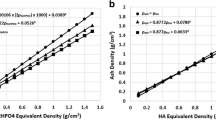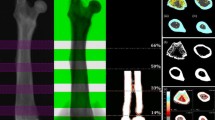Abstract
Summary
Few studies exist for bone densitometry of the whole foot. A phantom study demonstrated the sources of error and necessary controls for accurate quantitative computed tomography of the foot. A loss in bone mineral density (BMD) in the small foot bones may be an early indicator of diabetic foot complications.
Introduction
Volumetric quantitative computed tomography (vQCT) facilitates the assessment of pedal bone osteopenia, which, in the presence of peripheral neuropathy, may well be an early sign of diabetic foot deformity. To date, sources and magnitudes of error in foot vQCT measurements have not been reported.
Methods
Foot phantoms were scanned using a 64-slice CT scanner. Energy (in kilovoltage peak), table height, phantom size and orientation, location of “bone” inserts, insert material, location of calibration phantom, and reconstruction kernel were systematically varied during scan acquisition.
Results
Energy (in kilovoltage peak) and distance from the isocenter (table height) resulted in relative attenuation changes from −5% to 22% and −5% to 0%, respectively, and average BMD changes from −0.9% to 0.0% and −1.1% to 0.3%, respectively, compared to a baseline 120-kVp scan performed at the isocenter. BMD compared to manufacturer-specified values ranged, on average, from −2.2% to 0.9%. Phantom size and location of bone-equivalent material inserts resulted in relative attenuation changes of −1.2% to 1.4% compared to the medium-sized phantom.
Conclusion
This study demonstrated that variations in kilovoltage peak and table height can be controlled using a calibration phantom scanned at the same energy and height as a foot phantom; however, error due to soft tissue thickness and location of bones within a foot cannot be controlled using a calibration phantom alone.



Similar content being viewed by others
References
Sohn MW, Stuck RM, Pinzur M, Lee TA, Budiman-Mak E (2010) Lower-extremity amputation risk after Charcot arthropathy and diabetic foot ulcer. Diabetes Care 33(1):98–100
Sinacore DR, Hastings MK, Bohnert KL, Fielder FA, Villareal DT, Blair VP 3rd, Johnson JE (2008) Inflammatory osteolysis in diabetic neuropathic (Charcot) arthropathies of the foot. Phys Ther 88(11):1399–1407
Rajbhandari SM, Jenkins RC, Davies C, Tesfaye S (2002) Charcot neuroarthropathy in diabetes mellitus. Diabetologia 45(8):1085–1096
Brodsky JW (1993) The diabetic foot. Surgery of the foot and ankle, 6th edn. Mosby Year Book, St. Louis
Schon LC, Weinfeld SB, Horton GA, Resch S (1998) Radiographic and clinical classification of acquired midtarsus deformities. Foot Ankle Int 19(6):394–404
Chantelau E, Kimmerle R, Poll LW (2007) Nonoperative treatment of neuro-osteoarthropathy of the foot: do we need new criteria? Clin Podiatr Med Surg 24(3):483–503, ix
Genant HK, Ettinger B, Cann CE, Reiser U, Gordan GS, Kolb FO (1985) Osteoporosis: assessment by quantitative computed tomography. Orthop Clin North Am 16(3):557–568
Gluer CC, Reiser UJ, Davis CA, Rutt BK, Genant HK (1988) Vertebral mineral determination by quantitative computed tomography (QCT): accuracy of single and dual energy measurements. J Comput Assist Tomogr 12(2):242–258
Lang TF, Augat P, Lane NE, Genant HK (1998) Trochanteric hip fracture: strong association with spinal trabecular bone mineral density measured with quantitative CT. Radiology 209(2):525–530
Hounsfield GN (1980) Nobel Award address. Computed medical imaging. Med Phys 7(4):283–290
Cann CE, Genant HK (1980) Precise measurement of vertebral mineral content using computed tomography. J Comput Assist Tomogr 4(4):493–500
Kalender WA (1992) A phantom for standardization and quality control in spinal bone mineral measurements by QCT and DXA: design considerations and specifications. Med Phys 19(3):583–586
Robb RA (2001) The biomedical imaging resource at Mayo Clinic. IEEE Trans Med Imaging 20(9):854–867
Bland JM, Altman DG (1986) Statistical methods for assessing agreement between two methods of clinical measurement. Lancet 1(8476):307–310
Boone JM (2010) Method for evaluating bow tie filter angle-dependent attenuation in CT: theory and simulation results. Med Phys 37(1):40–48
Engelke K, Adams JE, Armbrecht G, Augat P, Bogado CE, Bouxsein ML, Felsenberg D, Ito M, Prevrhal S, Hans DB, Lewiecki EM (2008) Clinical use of quantitative computed tomography and peripheral quantitative computed tomography in the management of osteoporosis in adults: the 2007 ISCD Official Positions. J Clin Densitom 11(1):123–162
Griffith JF, Genant HK (2008) Bone mass and architecture determination: state of the art. Best Pract Res Clin Endocrinol Metab 22(5):737–764
Bolotin HH (2007) DXA in vivo BMD methodology: an erroneous and misleading research and clinical gauge of bone mineral status, bone fragility, and bone remodelling. Bone 41(1):138–154
Bligh M, Bidaut L, White RA, Murphy WA Jr, Stevens DM, Cody DD (2009) Helical multidetector row quantitative computed tomography (QCT) precision. Acad Radiol 16(2):150–159
Hangartner TN, Short DF (2007) Accurate quantification of width and density of bone structures by computed tomography. Med Phys 34(10):3777–3784
Bousson V, Le Bras A, Roqueplan F, Kang Y, Mitton D, Kolta S, Bergot C, Skalli W, Vicaut E, Kalender W, Engelke K, Laredo JD (2006) Volumetric quantitative computed tomography of the proximal femur: relationships linking geometric and densitometric variables to bone strength. Role for compact bone. Osteoporos Int 17:855–864
Biswas D, Bible JE, Bohan M, Simpson AK, Whang PG, Grauer JN (2009) Radiation exposure from musculoskeletal computerized tomographic scans. J Bone Joint Surg Am 91(8):1882–1889
Tanaka C, Ueguchi T, Shimosegawa E, Sasaki N, Johkoh T, Nakamura H, Hatazawa J (2006) Effect of CT acquisition parameters in the detection of subtle hypoattenuation in acute cerebral infarction: a phantom study. AJNR Am J Neuroradiol 27(1):40–45
Zerhouni EA, Boukadoum M, Siddiky MA, Newbold JM, Stone DC, Shirey MP, Spivey JF, Hesselman CW, Leo FP, Stitik FP et al (1983) A standard phantom for quantitative CT analysis of pulmonary nodules. Radiology 149(3):767–773
Prior F, Commean P, Ju T, Hastings M, Hildebolt C, Sinacore D (2007) Developing a biomarker for neuropathic arthropathy in diabetic patients. In: Xplore I Life Science Systems and Applications Workshop, Bethesda, MD, pp 13–16
Commean PK, Kennedy JA, Bahow KA, Hildebolt CF, Liu L, Smith KE, Hastings MK, Ju T, Prior FW, Sinacore DR (2011) Volumetric quantitative computed tomography measurement precision for volumes and densities of tarsal and metatarsal bones. J Clin Densitom 14:313–320
Acknowledgements
Funding for this project was provided by the National Institutes of Health, National Institute of Diabetes, Digestive and Kidney Diseases (1 R21 DK079457-03). We thank Tim Street, CT technologist within the Clinical Center for Imaging Research (CCIR) for his help with CT image acquisition for this project. The CCIR is supported in part by the National Center for Research Resources (NCRR), a component of the National Institutes of Health (NIH) (1 UL1 RR024992-01). We also thank Dr. Charles Hildebolt for the statistical assistance.
Conflicts of interest
None.
Author information
Authors and Affiliations
Corresponding author
Rights and permissions
About this article
Cite this article
Smith, K.E., Whiting, B.R., Reiker, G.G. et al. Assessment of technical and biological parameters of volumetric quantitative computed tomography of the foot: a phantom study. Osteoporos Int 23, 1977–1985 (2012). https://doi.org/10.1007/s00198-011-1851-3
Received:
Accepted:
Published:
Issue Date:
DOI: https://doi.org/10.1007/s00198-011-1851-3




